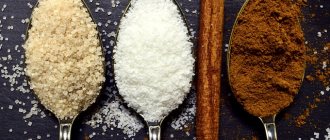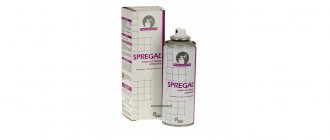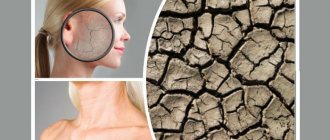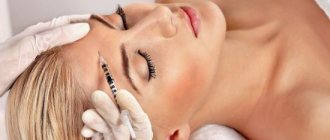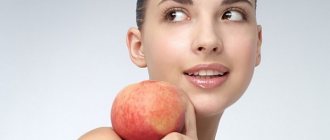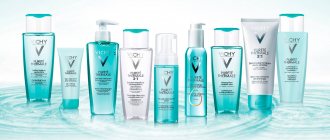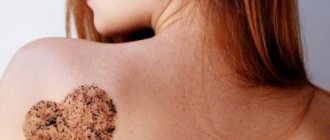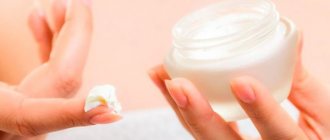Many women, with the onset of a certain period of life, begin to experience problems with their facial skin, and deterioration occurs not only externally, affecting beauty, it all comes from the inside due to deteriorating health and the functioning of internal organs. In this case, it is necessary to use vitamin complexes that help restore health and beauty. If you choose the right products and use doctors’ recommendations, you can achieve the fastest and most noticeable results. The article presents the best vitamins for facial skin in 2020 from different brands. All of them have a positive effect, have many good reviews and are recommended by doctors and cosmetologists.
What can a face tell?
Based on appearance, an experienced clinician can tell almost everything about a person's physical and mental health.
Let's consider the most common manifestations of diseases on the face, confirmed by medical practice:
- Yellowish-brown pigment spots are a kidney pathology, and light spotted spots indicate pregnancy.
- Accordion-shaped forehead, strewn with transverse wrinkles – a tendency towards alcoholism.
- Bluish lips and pink, red cheeks – mitral heart disease.
- A deep fold between the eyebrows is a sign of the presence of chronic pain syndrome in a protracted form.
- Dark circles under the eyes (bags) are a disease of the bladder and kidneys.
- Wrinkled face in youth – endocrine disorders.
- Loose skin is a metabolic disorder, the functioning of the gastrointestinal tract.
- A sallow complexion is the first “bell” to get checked for cancer.
- Capillary network on the cheeks – increased blood pressure, tendency to stroke.
- General puffiness of the face – heart problems.
- Dry lips with stickiness – stomach ulcer, gastritis.
- Yellowness of the sclera of the eyes - a diseased liver.
- Waxy pallor of the face is a symptom of tuberculosis, bluish pallor is a symptom of anemia. Purple color indicates blood stagnation.
- A pale tip of the nose is a sign of poor circulation.
- Redness and pimples on the chin are abnormalities in the functioning of the appendages and ovaries.
- Enlarged pores on the wings of the nose are diseases of the respiratory system.
- Shiny, protruding eyes mean problems with the thyroid gland.
- Acne on the forehead is a disorder of the small intestine.
Thus, a person’s face is a “map” of the health status of internal organs, which will help you understand your body more easily. Of course, rashes in any area are not a reason to diagnose yourself; perhaps you are not eating well, do not cleanse your skin enough, or are lacking vitamins. However, if pimples, age spots or redness systematically appear in the same places, you should consult a doctor to check the functioning of the corresponding body organ.
Skin types and characteristics
To nourish each type of dermis, you need your own set of vitamins. There are four types of skin: combination, dry, oily, normal. The first three types are problematic and require special care.
Normal skin is elastic, has a fresh appearance, a smooth, even surface, without inflammation, rashes, or oily sheen. Pores and shallow wrinkles are invisible on it.
Table No. 1 “Features of each skin type”
| Skin type | a brief description of |
| Normal | Elastic, has a healthy appearance, does not cause discomfort (tightness, oily shine). |
| Combined (mixed) | This is the most common skin type among women. It is easy to identify: increased fat secretion in the forehead, nose and dry (normal condition) cheeks. |
| Fat | Dense, with poor blood supply and clogged enlarged pores. It constantly becomes covered with an oily sheen, which especially intensifies in the hot season. Due to increased activity of the sebaceous glands and improper care, clogged pores become inflamed and itching appears. Owners of this skin type are more likely to have acne than others. However, oily dermis is less susceptible than others to adverse environmental factors, and therefore is less susceptible to the aging process. Increased “greasy” skin can be caused by a lack of vitamins E, B2, and the frequent occurrence of dermatitis, allergic reactions, and irritations - B6, B9, B12, H, C . |
| Dry | Thin, beautiful with a soft matte shade. Minor inflammation and enlarged pores rarely appear on it. Highly susceptible to negative environmental factors (exposure to ultraviolet rays, wind, frost), which cause a feeling of tightness and flaking. Dry skin is most susceptible to premature aging and the appearance of small networks of folds and wrinkles. Due to lack of moisture, such dermis quickly loses its elasticity. Excessive dryness of facial skin can be caused by a deficiency of vitamins A, E, C, PP in the body. |
Signs of acute lack of nutrients in the body, visible to the naked eye:
- development of dermatitis;
- the appearance of irritation, rash, redness on the skin;
- increased hair loss;
- long-healing wounds;
- dandruff, itchy scalp;
- the appearance of bruises, hematomas with minor contusions of soft tissues;
- decreased skin elasticity (premature formation of folds);
- dryness and pallor of the dermis;
- hyperpigmentation;
- red spots, acne;
- drying and cracking of lips.
Thus, the skin signals a lack of biologically active compounds in the body. Long-term nutrient deficiency threatens the appearance of characteristic diseases (polyneuritis, beriberi, pellagra, scurvy, rickets), pathologies of vital organs and systems (heart, liver, kidneys, nerve cells, skeleton).
Regardless of the time of year or the functional state of the body, dry and oily skin always needs additional nutrition. The main vitamins that you should pay attention to are A, E, B, C, PP. A lack of these compounds in the body leads to inflammation, peeling, roughness of the dermis, the appearance of early expression wrinkles, subcutaneous capillary networks, excessive dryness and the accumulation of toxins in the skin.
To replenish nutrients, the daily diet is enriched with the following products:
- carrots, beef liver, butter, cottage cheese, spinach, red bell pepper, fish (vitamin A);
- natural oils, nuts, apples, legumes, corn, wheat sprouts (vitamin E);
- citrus fruits, greens, rose hips, sea buckthorn, black currants, tomatoes (vitamin C);
- cow's milk, nuts, cattle meat, cabbage, eggs, fish (B vitamins).
Hormonal tablets to combat acne
Hormonal pills are prescribed if a woman’s skin rashes are caused by increased testosterone levels. Birth control pills can change hormonal levels and normalize the functioning of the sebaceous glands, thus the problem of acne will be solved quite quickly. The best medications of this type are presented in the list below:
- Contraceptive "Yarina" . Doctors prescribe it to women with skin rashes. The drug is taken in a three-week course.
- "Jess" is a hormonal drug that helps get rid of acne. It has an affordable price, but can cause allergic reactions. Take tablets regularly, 1 piece per day.
- "Janine" is a birth control pill that also effectively helps get rid of acne. This drug to improve the appearance of the skin is allowed to be taken only as prescribed by a doctor.
Good medications that protect against unwanted pregnancy can really save you from acne. However, remember that they are not products that are aimed at combating unwanted inflammation on the skin in the first place. They have many contraindications, so they are recommended to be used only after the approval of the attending physician.
Vitamins for the face
Facial skin color depends on the environment (level of solar radiation), genetic factors and dietary habits, and adherence to a rest regime.
Four pigment components are concentrated on the surface of the dermis, which give it a characteristic shade: melanin (brown), carotene (yellow-orange), carboxyhemoglobin (purple), oxyhemoglobin (red). The presence of freckles on the face means a reduced level of the photoprotective component - melanin. Such skin (with brown spots) is most vulnerable to the aggressive effects of ultraviolet radiation. In direct sunlight, it quickly dries out, burns, and becomes inflamed.
During the day, the sebaceous glands of the dermis produce 20 grams of sebum, which with sweat forms a protective membrane on the face, protecting the surface from bacterial and fungal damage. On the problem T-shaped area of the face (chin - wings of the nose - forehead), their number reaches up to 900 pieces per 1 square centimeter.
Excessive sebum production and improper care contribute to clogged pores and the appearance of blackheads - comedones, which lead to inflammation on the face.
TOP 8 nutrients involved in the healing and restoration of the epithelial layer of the face:
- Vitamin A. Reduces sebum production, prevents acne, has a wound-healing effect, and fights facial inflammation. Vitamin A regenerates dermal cells, smoothes stretch marks, promotes increased collagen production, and eliminates age spots, which is why it is actively used in anti-aging cosmetics.
- B vitamins. Moisturize the skin, reduce the number of wrinkles on the face. Thiamine (B1) prevents premature aging of the dermis, riboflavin (B2) accelerates metabolism and ensures cellular respiration. Pantothenic acid (B5) smoothes folds (wrinkles), pyridoxine (B6) treats skin diseases, folic acid (B9) gets rid of acne, cyanocobalamin (B12) is involved in cell renewal, rejuvenating the epidermis. In addition, B vitamins improve facial tone, blood circulation, and give the dermis a healthy, radiant appearance. These are natural antioxidants that neutralize and remove harmful toxins from the body.
- Vitamin C. Responsible for skin elasticity, destroys free radicals, destroys melanin, which causes brown pigment spots to appear, strengthens blood vessels, stimulates collagen production, heals microcracks.
- Vitamin E. The most important nutrient for facial skin. Its effect on the dermis is difficult to overestimate, since it slows down cell aging, fights free radicals, improves blood circulation, and protects against ultraviolet rays.
Vitamin E is an anti-aging factor that prolongs the youth of the skin. Tocopherol smoothes, tightens, soothes the dermis, gives it elasticity, a radiant healthy appearance, removes inflammation, irritation, and slows down photoaging.
To nourish dry skin, vitamin E is recommended to be used internally (with food, dietary supplements, vitamins) and externally (as masks). Only an integrated approach will help resist age-related changes.
Thanks to its miraculous properties, almost every cosmetic company introduces tocopherol into products for the care of aging, problem skin.
- Vitamin D. Promotes the absorption of calcium, maintains skin tone.
- Vitamin K. Fights inflammatory processes in the dermis, swelling, age spots, freckles. Vitamin K gets rid of dark circles under the eyes, pimples, blackheads.
Phylloquinone-based products are used to treat earthy-colored dermis, eyelid tightening, and lightening of the skin in the eye area.
- Vitamin RR. Improves facial tone, makes skin elastic, smoothes wrinkles.
- Vitamin H. Stimulates cells to regenerate, participates in metabolic processes (carbohydrate, fat), does not allow microelements and radicals that cause pigmentation of the upper layer of the dermis to pass through, eliminates old spots and prevents the formation of new ones.
Skin problems:
- peeling – deficiency of vitamins A, PP, B2, B5, B6;
- acne, pimples - lack of A, E, C, B2, B6, H;
- flabbiness, withering - insufficiency of A, K, E, PP, C;
- swelling, pigment spots, pale complexion – deficiency of PP, B3, C.
Omega-3 fats, alpha-lipoic and hyaluronic acids, astaxanthin, mineral supplements (calcium, fluorine, phosphorus) that stop the course of inflammatory processes, give elasticity to the dermis, protect cells from damage from the inside and outside (toxins, free radicals) deserve special attention. , maintain cleanliness, elasticity of aging skin, a high level of hydration, eliminate dryness, oily shine and flaking.
What foods can you use to compensate for the lack of vitamins?
Vitamin A (retinol) is found in animal and fish liver, dairy products, eggs, carrots, various greens, beans, prunes and mushrooms.
Vitamin B1 (thiamine) is found in sprouted wheat grains, oat and barley flour, meat and fish, as well as legumes.
The deficiency of vitamin B2 (riboflavin) can be compensated for by eating pears, tomatoes, peaches, dairy products, eggs, and spinach.
Vitamin B5 is found in legumes, rice, and bran. Vitamin B6 is found in avocados, fish, bananas, and rice.
If you eat cottage cheese, cheese, fish, beef and tomatoes, you will not experience vitamin B12 deficiency.
Vitamin C (or ascorbic acid) is found in citrus fruits, rose hips, sauerkraut, black currants, and viburnum berries.
Vitamin E is found in various oils: olive, pumpkin, corn, sunflower, etc.
To compensate for the lack of vitamin D, you should eat fish (sea), eggs, and cod liver. This element also has the ability to be synthesized independently under the influence of sunlight.
Vitamin K is found in cabbage, spinach, and whole grains. Vitamin PP (or nicotinic acid) is found in brewer's yeast, buckwheat, wheat, and soybeans.
Vitamin H (biotin) is rich in egg yolks, as well as meat, cheese and milk.
Overdose and contraindications
Despite the undeniable benefits of each nutrient, it is important to maintain moderation in its use. Excessive uncontrolled intake of vitamins, macro- and microelements causes a malfunction in the body, which “hits” the functioning of all internal organs and systems.
First of all, the liver, which accumulates them, suffers from an overdose of nutrients. Water-soluble vitamins do not pose a risk to human health (B, C); excess compounds are excreted in the urine. Fat-soluble nutrients (A, D, K, E) in excess quantities can cause intoxication of the body. External manifestations: nausea, lethargy, fatigue, headaches, depression, colic, muscle discomfort, irritability, loss of coordination.
Contraindications to the use of vitamins: inability to absorb the product, allergic reactions (redness of the skin, burning, itching). If adverse reactions occur, you should stop taking the drug and consult a doctor.
How to take vitamins for the face?
Any skin, regardless of type, requires regular nutrition. Improper care can lead to problems such as excessive dryness and premature aging.
How to deliver vitamins to their destination - to cells so that they function at full strength?
Ways to consume nutrients:
- Vitamin complexes. Such drugs not only support the internal functioning of the body, but also deliver beneficial compounds to skin cells from the blood. After a course of vitamin therapy, you will see that the condition of the dermis has improved significantly.
- Cosmetic procedures. This category includes professional, store-bought and homemade masks that locally nourish the skin of the face.
- Individual vitamins. First of all, you need to determine which nutrient your skin lacks. Then, instead of the complex, purchase the missing vitamin. At the same time, its release form does not matter. These can be powders, tablets, capsules.
- Nutrition. Eliminate carbonated drinks, fast food, confectionery, and baked goods from your daily diet. Replace them with cereals, fruits, vegetables, and natural juices.
To improve the condition of facial skin, the ideal option is a competent combination of all methods.
Remember, an excess of vitamins is no less dangerous for the dermis than their deficiency, so follow the following recommendations.
Rules of application:
- Determine the purpose of nutrient intake. To eliminate specific problems (dryness, oily shine, flaking of the skin), take a course of certain vitamins, the deficiency of which causes these problems.
For preventative purposes, for general cell nutrition, give preference to a complex consisting of a set of vital organic substances “packed” into one capsule. Advantages of vitamin preparations: wide spectrum of action, covering the daily requirement of essential vitamins, macro- and microelements, synergy effect. The latter, in turn, lies in the fact that most nutrients work in conjunction, thereby enhancing each other’s effects. Thus, vitamin A improves the absorption of iron, B6 - magnesium, D - calcium, phosphorus.
Thus, vitamin-mineral complexes help many elements “meet” at one time and work as a team.
- Consult a dermatologist regarding specific nutrient intake. The doctor will determine the cause of the deterioration of the skin condition (the problem is not always a lack of vitamins or minerals in the body), and will prescribe an individual comprehensive treatment.
- Start eating right. Follow a daily routine, eat at least 3-4 times a day. The breaks between meals should not exceed 4 hours, otherwise the liver may not be able to withstand the sharp change in the “fasting” - “overeating” phases.
To improve your skin condition, drink at least 2 liters of clean water a day, switch to vegetable side dishes, and never skip breakfast. Replace baked goods and sweets with fruits and dried fruits, and strong drinks and soda with juices. Instead of fast food, eat dietary lean meat (turkey, chicken, rabbit) or fish (hake, pollock).
To cleanse the body and remove toxins, arrange a fasting day once a week, during which you eat exclusively cottage cheese and drink green tea. Avoid pickled, canned, smoked and semi-finished products. The last meal is 3 hours before bedtime, do not wash down your food, wait at least 1 hour.
- Do not combine vitamin complexes with individual vitamins: choose one thing.
- Nourish your skin regularly once a week. Make fortified masks based on fresh fruits and vegetables (cucumber, zucchini, apricots, citrus fruits, strawberries, peach), seasoned with natural yogurt, sour cream, egg yolk, potato starch.
- The minimum break between taking vitamin complexes is 2 months.
To maintain youth, health and beauty of the skin, make sure that the cells do not lack vitamins A, B, C, E, PP, D, K, H. A deficiency of one of them leads to a deterioration in the condition of the dermis. As a result, all problems will worsen and come to light.
How effective are vitamin-based cosmetics?
Vitamins, when used externally, act at the sites of application, and not in a complex manner, like food and nutritional supplements. Microelements do not penetrate into the blood and do not spread throughout the body, but are able to overcome the epidermal barrier and have a local therapeutic effect. Manufacturers add them to cosmetics to solve the following problems:
- acne;
- skin aging;
- seborrhea;
- dry skin;
- dark spots.
Forms of release of vitamins
Liquid in ampoules. It is recommended to rub in B vitamins in their pure form in 10-20 day courses. In this case, the best effect is achieved if you alternate the application of thiamine (B1) and pyridoxine (B6) one ampoule every other day. Don't mix them together. In addition, to moisturize the skin and eliminate dryness, apply a solution of retinol (A) and tocopherol (E) ampoules to a clean face, leave for half an hour, then rinse off. The duration of the course is 10 days.
Cosmetologists recommend adding liquid vitamins (in ampoules) to nourishing creams. To moisturize the face, retinol (A) is added to skin care products, and phylloquinone (K) is added to remove pigmentation, freckles and protect against ultraviolet radiation. The resulting vitamin mixtures are applied to the dermis, avoiding the area around the eyes (daily or every other day) for a week.
During the cold season - late autumn, winter, the skin's sensitivity to environmental factors worsens. Temperature changes, frost, snow, rain, wind negatively affect the condition of the epidermis. During this period, the skin, more than ever, needs regeneration of dead cells and hydration.
- In capsules. The main vitamins for maintaining youthful facial skin are A, E, C. Capsules can be taken internally or used externally (open, rub the oil with massage movements into the upper layer of the dermis). The course of therapy is 20 days, 2 times a day. To consolidate the effect for preventive purposes, it is repeated after 2–3 months.
- In tablets. Dragees are taken orally after meals 1-3 times a day, depending on the type of nutrient and the condition of the face, with plenty of water. After a month of regular use of vitamins, peeling of the skin goes away, it is saturated with moisture, acquires a healthy color and smoothness.
Vitamins for acne
Acne is a disease of the sebaceous glands. The surface of the human body is strewn with pores that secrete sebum to nourish the dermis. When they become clogged, a kind of traffic jam appears. If you don’t take action and don’t cleanse your face, the skin becomes inflamed and the pathogenic bacteria “Propionibacterium acnes” begin to multiply inside it. As a result, comedones form and pustules appear. If the immune system wins, the pimple decreases, the plug dissolves, and it’s time to start performing the usual task again - sebum secretion. Otherwise, the inflammatory process progresses, the follicle is filled with pus.
Causes of acne:
- hormonal disorders;
- lack of micro- and trace elements, vitamins, in particular zinc, tocopherol, ascorbic acid, riboflavin, pyridoxine, biotin;
- poor nutrition;
- digestive problems (dysbacteriosis, gastritis, liver disease, kidney stones);
- improper skin care, inadequate hygiene;
- emotional stress;
- disruptions in the immune system;
- climatic factors;
- subcutaneous mite;
- genetic predisposition;
- allergic reactions.
Methods to combat acne:
- Zinc ointment. Removes harmful substances, stimulates protein production, wound healing, reduces sebum production, thereby fighting comedones.
To treat acne, apply a thin layer of ointment to a cleansed face 5 times a day. It can be left on all night. At the same time, remember that you cannot apply tone or cosmetics to the zinc ointment. In addition, during treatment, limit the consumption of foods fortified with copper, since this element acts as a strong blocker. As a result, it nullifies all the changes obtained by zinc.
To cleanse the skin and consolidate the result, the ointment is used daily for 2.5 months.
- Salicylic ointment. It is a powerful drying agent. It fights oily skin and relieves inflammation. Salicylic ointment 2% is applied to pimples for 2 months.
To avoid causing irritation and dryness, do not treat entire skin with this product.
- Acne cream. Ingredients: lanolin (5 milliliters), grape oil (200 milliliters), aloe vera gel (100 milliliters), jojoba oil (4 milliliters), ascorbic acid tablets (10 pieces), vegetable wax (30 milliliters), lavender or tea essential oil wood (2 drops). To prepare the mask, use sterile containers. Mix lanolin, oil, wax in one container, place in the microwave for 1.5 minutes until the components are completely dissolved, add essential oil. Place the resulting mass in the refrigerator. Apply the product to your face daily as you would a regular cream. In addition to cleansing and nourishing, it will get rid of wrinkles.
- Get enough sleep (at least 8 hours).
- Get rid of bad habits.
- Eat foods rich in vitamins B, E, D, which relieve skin irritation, accelerate wound healing, and improve the epithelial layer. These include: eggs, peas, beans, liver, sprouted wheat, lettuce, tomatoes, spinach. Eliminate fatty, sweet foods.
- Regularly apply antiseptics (masks, creams) to your face, which disinfect the upper layers of the dermis from bacteria, dirt and dust particles.
Basic rules for the use of medicines
To achieve only the positive effect of drugs from the pharmacy, follow a number of rules:
- Before you start using this or that product to give your face health and youth, familiarize yourself with its composition. Some substances moisturize the skin, while others dry it out. Incorrect use can cause negative consequences.
- Talk to a therapist, endocrinologist, gastroenterologist and cosmetologist. It is possible that problems with facial skin arise due to diseases of the internal organs.
- Check expiration dates before using medications. Never use a product if you are in doubt about its origin. Counterfeit products can greatly harm your health.
- Before use, it is recommended to test for adverse reactions. Individual intolerance to some components can cause serious deterioration in health, which will require further use of skin allergy pills.
- Apply any masks, ointments and other products to scrubbed skin. This will enhance the effect of the drugs.
- Store facial medications as directed by the manufacturer.
To effectively combat the appearance of acne on the face, it is necessary to use cleansing creams and lotions suitable for oily facial skin.
Ascorutin (vitamin P) against pigmentation
For every person, a face is his calling card. Well-groomed, clean, smooth skin attracts the attention of passersby and gives confidence to the owner. However, this is the first organ that suffers and sends signals that the body is still silent about. Thus, he indicates that he needs help.
Pigmentation is the appearance of brown spots on the skin. They can appear on the face, body, legs, arms. People with sensitive skin, which needs natural protection, suffer especially acutely from them.
Causes of age spots:
- deficiency of vitamins C and P;
- diseases of the liver, endocrine system;
- heredity;
- age-related changes (menopause);
- increased production of hormones (during pregnancy or menstrual irregularities);
- exposure to ultraviolet rays;
- stress;
- weakening of the immune system.
Despite the etiology of skin pigmentation, to eliminate unwanted spots, doctors recommend the most effective method - taking ascorutin. To speed up the process and consolidate the result, it is combined with ascorbic acid. In combination, vitamins P and C (the drug “Ascorutin”) normalize the restoration process of the dermis.
To remove age spots, freckles and whiten the face, take the vitamin complex 2-3 times three times a day. Do not increase the prescribed dose, otherwise you may harm the body. It takes time for the epidermis to fully recover. The drug can be used as part of face masks.
To nourish and lighten problem skin, mix the following ingredients: corn flour (5 grams), ascorutin (3 tablets), olive oil (3 drops), mix and apply the mixture to the dermis an hour before bedtime. Wait 20 minutes, rinse with warm water.
In addition, ascorutin helps restore the body:
- strengthens blood vessels, prevents the appearance of varicose veins;
- improves the condition of rheumatism;
- prevents the development of pathologies of the spinal cord and brain;
- Provides strength, recharges with vigor after suffering infectious diseases.
The best vitamins from Russian manufacturers
I chose 2 vitamin complexes for oral administration, produced in Russia.
COMPLIVIT SHINE
The drug "Complivit Radiance" contains green tea extract - a powerful antioxidant, as well as lipoic acid, 19 vitamins and minerals. The active composition has a beneficial effect on the body as a whole and appearance:
- improves skin tone;
- prevents collagen breakdown;
- increases protection against UV radiation and toxins;
- promotes tissue regeneration;
- strengthens the cardiovascular system;
- improves digestion.
Volume: 30 tablets.
Production: Russia.
Class: mass market.
Yobaton Protein shake “Whey Protein” with strawberry flavor
Low-calorie protein shake Whey Protein contains vitamins C, B1, B3, B5, B6 and folic acid. It is needed to maintain tone and recovery in sports nutrition and weight loss programs. The cocktail replaces a meal, and the feeling of satiety lasts, according to reviews, for 2-3 hours.
Volume: 900 g.
Production: Russia.
Class: middle market.
Vitamins for the skin around the eyes
The area around the eyes is the most sensitive, which is why the first expression lines, drooping eyelids, crow's feet, and dark circles appear in this area. Vitamins A and E will help slow down aging. They participate in metabolic reactions, have a regenerating effect, and promote the production of collagen and elastin, which are responsible for skin elasticity.
Tocopherol deserves special attention, as it has a pronounced moisturizing, tightening and rejuvenating effect. Vitamin E capsules and oil are used to care for sensitive skin in the eye area.
The effect of vitamin E on the dermis:
- Rejuvenation and lifting. Under the influence of tocopherol in skin cells in adulthood, most of the aging processes slow down, crow's feet are smoothed out, the fading dermis around the eyes is regenerated, saggy folds on the eyelids are tightened, the production of collagen fibers and elastin increases, blood circulation improves, and cell nutrition with oxygen is improved.
- Toning and refreshing. Vitamin E improves skin color (gives it a fresh look), removes signs of fatigue, strengthens cell membranes, and eliminates dark circles under the eyes.
- Hydration. Prevents the evaporation of moisture from fabrics.
- Antioxidant action. Protects cells from free radicals that stop the production of elastin and collagen.
- Therapeutic effect. Eliminates allergy symptoms, prevents skin cancer, protects red blood cells from destruction.
Vitamin E is, first of all, a drug with which you need to be extremely careful so as not to harm your health.
Features of application:
- Inside with food. Natural sources of tocopherol: fresh vegetables (broccoli, onions, lettuce, cucumbers), berries (sea buckthorn, rowan, cherries), beans (peas, beans), grains (oatmeal), animal products (egg yolk, milk, liver), unrefined vegetable oil (sunflower, corn, pumpkin, olive), seafood (squid, pike perch), seeds and nuts (almonds, peanuts, pistachios, hazelnuts), herbs (rose hips, raspberry leaves, flax seeds, alfalfa, nettle, dandelion) . These products can be used as components for masks to nourish the skin.
There is no vitamin E in canned or frozen vegetables.
- Pharmacy drugs. Vitamin E is produced in the form of transparent capsules of rich color, filled with a homogeneous liquid, oil (“Alpha-tocopherol acetate”) and ampoules for injection. In the first case, the drug is taken 8 milligrams per day, in the second - 15 milliliters. Tocopherol in ampoules is used extremely rarely due to its very liquid consistency.
To prepare compresses and face masks, use vitamin E oil or capsules, which are pierced with a needle, squeezing out the liquid from it. Before applying the composition to your face, make sure that tocopherol is safe and that there is no allergic reaction to the product. The vitamin mixture is knocked into the skin of the eyelids with light tapping movements with the pads of your fingers. The duration of the mask around the eyes is 15 minutes. After applying the product to the skin, do not strain your facial muscles with unnecessary emotions or facial expressions. At this time, it is better to meditate, lie down, and relax. Remove the remaining mask with warm herbal infusion of chamomile using a napkin. To complete the procedure, apply a moisturizing or rejuvenating gel cream to the skin around the eyes.
To eliminate crow's feet and bruises, as well as relieve swelling from the eyelids, masks with vitamin E are made every 2 to 3 days, depending on the condition of the dermis.
Regular care is the key to healthy and beautiful skin for many years!
Recipes for eye masks with tocopherol:
- Moisturizing. Relieves flaking, dryness and tightness of the eyelid skin. Thoroughly mix 10 milliliters of almond (burdock or jojoba) oil at room temperature with the contents of two tocopherol capsules. Apply the vitamin mixture under the eyes with massage movements, leave until completely absorbed.
- Brightening. Fights dark circles and bags in the vision area. To lighten dark circles under the eyes, mix 10 milliliters of nettle infusion with a warm chamomile infusion and 10 grams of crushed rye bread pulp. The resulting mixture should have the consistency of a thick paste. Add 5 milliliters of an oily tocopherol solution to the finished mass and mix. Apply the mask to the skin for 20 minutes, remove any residue with a napkin.
- Lifting. Prevents the formation of folds in the lower eyelid and resists drooping of the upper eyelid. To tighten the skin around the eyes, mix half an ampoule of vitamin E, 15 milliliters of warm almond oil, and ½ part of the yolk. Distribute the mask on problem areas, leave for 30 minutes, rinse with warm water.
- Anti-aging. Smoothes wrinkles, eliminates crow's feet. To prepare a vitamin smear, squeeze the oil from two tocopherol capsules, mix it with 5 milliliters of parsley juice, apply the contents under the eyes.
Vitamin E is an active substance that has a rejuvenating and moisturizing effect, which is noticeable after the first use. Suitable for nourishing and soothing even the most sensitive, problematic skin.
Nutrient-rich foods for the dermis
Having found out which vitamins are good for the skin, it is advisable to find out the sources of these nutrients. There are so many products available that contain essential vitamins for skin health (see Table 2).
Table 2. The best vitamins and minerals in food ingredients for facial skin
| Nutrient | Products |
| A | Fish oil, beef liver, carrots, eel, red rowan. |
| AT 3 | Dried porcini mushrooms, peanuts, sunflower seeds, tuna, bran, turkey, rabbit, chicken, beef liver. |
| AT 5 | Chicken egg yolk, milk powder (low-fat). |
| AT 6 | Garlic, pistachios, seeds, bran. |
| AT 7 | In almost all fruits, vegetables and other common foods. |
| WITH | Rosehip, sea buckthorn, kiwi, bell pepper, parsley, dried mushrooms (white), orange, black currant. |
| E | sunflower oil, mayonnaise, seeds, hazelnuts, almonds, pine nuts, peanuts, margarine, peanut, olive, mustard oil, bran. |
| F | Flax seed, soybeans, nuts, sunflower oil, black currant, rolled oats, rice, seafood |
| Zinc | Cheese, pine nuts, bran, seeds. |
| Copper | Cereals, legumes, seafood, nuts, liver. |
| Selenium | Sunflower seeds, pink salmon, bran. |
Flaxseed oil and seafood are rich in omega 3. Alpha lipoic acid is found in large quantities in plant foods.
Food-grade natural vitamins are effective for improving facial skin. It is highly recommended that you consume the foods in Table 2 daily, only in moderation.
Conclusion
Vitamins for the face are a complex of nutrients that support and prolong the youth of the dermis, giving it a radiant, healthy appearance. The most important biologically active compounds for the skin are: A, B, C, E, P, K, D, PP, H. All of these vitamins are equally important and should be regularly supplied to the face from the inside (with food or pharmaceutical complexes) and from the outside ( as masks). The lack of one of them leads to the fact that the dermis loses its elasticity, becomes flabby, sagging, age spots appear, acne, the wings of the nose, the forehead and chin become covered with an oily sheen, and dry patches appear on the cheeks. As a result, the skin loses its healthy complexion, pores become clogged, and pockets of inflammation appear.
To maintain the dermis in normal condition, watch your diet; it should be balanced, enriched with healthy fatty acids (Omega type). The predominance of vegetables, fruits, and cereals is encouraged in the diet. To nourish and moisturize your skin from the inside, drink at least 2 liters of clean water per day (preferably more). Avoid carbonated drinks, smoked, pickled, fatty, confectionery, and baked goods. Take monthly vitamin courses regularly 2–3 times a year. To enhance the effect, it is recommended to perform cosmetic procedures: nourish the skin with fruit masks once a week. Remember, only an integrated approach can bring the desired result.
More fresh and relevant information about health on our Telegram channel. Subscribe: https://t.me/foodandhealthru
We will be grateful if you use the buttons:

